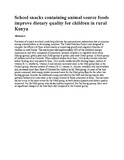School snacks containing animal source foods improve dietary quality for children in rural Kenya

View/
Date
2003Author
Murphy, SP
Gewa, C
Liang, LJ
Grillenberger, M
Bwibo, NO
Neumann, CG
Type
ArticleLanguage
enMetadata
Show full item recordAbstract
Provision of a snack at school could help alleviate the micronutrient malnutrition that is common among schoolchildren in developing countries. The Child Nutrition Project was designed to compare the efficacy of three school snacks in improving growth and cognitive function of children in rural Kenya. The snacks provided approximately 20% of the children's energy requirement, and were composed of equicaloric portions of githeri (a vegetable stew) alone (Energy group), githeri plus milk (Milk group) or githeri plus meat (Meat group). A fourth group of children served as Controls. When nutrient intakes from three, 24-h dietary recalls collected before feeding were compared to three, 24-h recalls conducted after feeding began, intakes of vitamin B-12, riboflavin, vitamin A and calcium increased more in the Milk group than in the Control group, whereas intakes of vitamin B-12, vitamin A, calcium, available iron and available zinc increased more than those of Controls for children in the Meat group. At most of the time points examined, total energy intake increased more for the Meat group than for the other two feeding groups, because the additional energy provided by the Milk and Energy snacks was partially balanced by a decrease in the energy content of foods consumed at home. This decrease did not occur to the same extent for the Meat group, so both dietary quantity and dietary quality improved. For the Milk group, only dietary quality improved. For the Energy group, there were no significant changes in the total day's diet compared to the Control group
URI
http://www.ncbi.nlm.nih.gov/pubmed/14672295http://erepository.uonbi.ac.ke:8080/xmlui/handle/123456789/15993
Citation
J Nutr. 2003 Nov;133(11 Suppl 2):3950S-3956SPublisher
Cancer Research Center of Hawaii, University of Hawaii, Honolulu, HI, USA. School of Public Health, University of California, Los Angeles, CA Division of Human Nutrition and Epidemiology, Wageningen University, Wageningen, The Netherlands School of Medicine, University of Nairobi, Nairobi, Kenya
Collections
- Faculty of Health Sciences (FHS) [10377]
